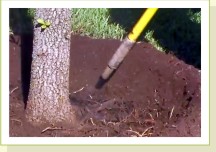Tree Root and Air-spade Services
What is an Air-spade
 An Air-Spade is a high powered compressed air gun used for excavating soil around trees without damaging the roots. The Air-Spade is fairly new technology in our industry. Previously there was no way to dig around trees without potentially damaging the bark or root tissue, allowing for the introduction of decay pathogens. The Air-Spade's high velocity stream of air blasts away loose materials such as dirt or mulch but doesn't tear or cut the delicate root tissue. It has become one of the most versatile and useful tools we have for addressing many of the tree health problems that originate below ground.
An Air-Spade is a high powered compressed air gun used for excavating soil around trees without damaging the roots. The Air-Spade is fairly new technology in our industry. Previously there was no way to dig around trees without potentially damaging the bark or root tissue, allowing for the introduction of decay pathogens. The Air-Spade's high velocity stream of air blasts away loose materials such as dirt or mulch but doesn't tear or cut the delicate root tissue. It has become one of the most versatile and useful tools we have for addressing many of the tree health problems that originate below ground.
Root Crown Excavation
One of the most common problems we find on urban trees are buried root crowns. The root crown is the transitional region at the base of the trunk where the trunk becomes the root system. The root crown is typically marked by the root flares, the large buttress roots at the base of the tree. This area should always be exposed to air and not covered with dirt or mulch, but often mature trees on urban sites have had backfill placed around the trunk as a result of construction or landscaping. Young transplants are often planted too deep. A buried root crown is an easy target for insects and pathogens that can weaken or even kill the tree. Additionally, over time buried root crowns can develop a condition known as girdling roots, where roots from the tree roots grow back around the buried trunk. As these roots age and swell they put pressure on the phloem, the vascular tissue beneath the bark. This interferes with the transport of sugars in the tree and can lead to root and canopy dieback and the eventual death of the tree.
Root crown excavation restores the soil around the tree to the original level. Using the Air-Spade we dig a tree well around the tree and prune away any girdling roots. Upon completion of the excavation work we can also discuss options for maintaining the proper soil depth or incorporating the new tree well into your existing landscape.
Air Tilling and Soil Decompaction
Soil compaction is another major problem for urban trees. Construction is one of the most common causes of compaction; however, regular vehicular and even foot traffic can also be a factor. Compaction destroys soil structure. The macropore spaces that allow the infiltration of moisture and air are collapsed, which in turn stresses the tree and deprives it of needed water and oxygen.
We use the Air-Spade to till the soil and restore soil structure in the tree's root zone. It allows us to work the soil without damaging tree roots like a traditional tiller would. We generally work the top few inches of soil where the majority of the feeder roots are. We also use it to incorporate compost into the soil to improve the organic content. We generally top the tilled soil off with a few inches of mulch to help limit recompaction and further improve root growing conditions.
Decompaction should always be undertaken as part of a larger plan to limit exposure of the ground around trees to future compaction.
